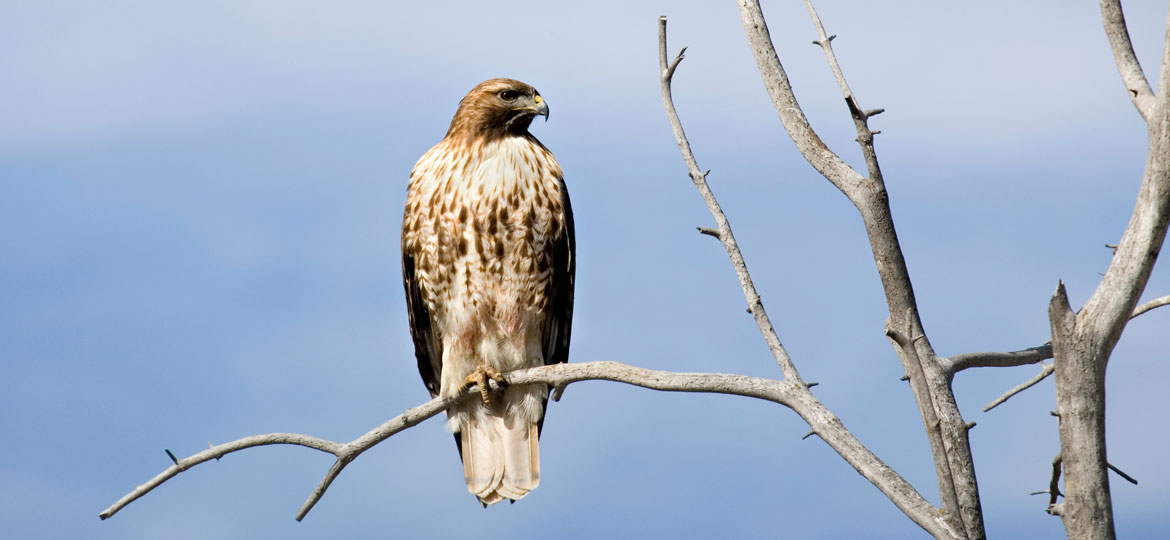
The Red-tailed Hawk (Buteo jamaicensis) is a familiar sight in Vermont, whether soaring over open farmland or perching in a tree along the highway. It is easily identified by its large size, white breast with brown in bands, and rust colored tail.
Habitat
The Red-tailed Hawk prefers deciduous or mixed woodlands with nearby pastures or agricultural fields. Prime hawk habitat should include open country in which to hunt, as well as scattered tall trees for nest sites and perches. Its large nest is often easily spotted in trees before they leaf out in the spring, generally in the crotch of a tree about 30 to 60 feet off the ground.
The Red-tailed Hawk is a monogamous, and will not only mate for life but will often inhabit the same territory year after year. It is very territorial and will regularly fly over its home range boundaries searching for intruders. The female is usually more protective of the nesting site while the male is more so of the entire territory.
In addition to its flight patterns used to warn off predators, the Red-tailed Hawk's repertoire of aerial displays also includes courtship rituals and various hunting techniques. It is excellent at soaring as well, and is capable of hanging motionless without beating its wings, simply floating in the wind.
Though the Red-tailed Hawk can be found in Vermont throughout the year, it is considered to be a migratory bird with many travelling south for the winter.
Reproduction
Although Red-tail Hawks winter in the open country in the Champlain Valley, many leave Vermont in the fall. They return to their breeding territories by early March to build or repair their already existing nests, built high in a tall tree, usually beech, oak or sugar maple, about 55 feet off the ground. They may also choose a rocky cliff site for their nesting location. The nest, a large structure out of sticks, is lined with shreds of bark and bits of fresh vegetation.
Before nesting, the Red-tailed Hawks perform an elaborate aerial courtship display. The male exhibits more of the acrobatics, but the female also demonstrates great speed and agility during these rituals. The birds fly high in to the sky, soar in wide circles while tipping their wings, and then dive towards the earth at high speeds. The male and female will intermittently rest on a perch during these displays, which is where the actual breeding occurs. Red-tails are monogamous, and will remain together for life.
After breeding has occurred, one to four eggs are laid in late March or April. The eggs are typically white and may have brown markings or fine speckles on them. Incubation begins with the first egg laid and both sexes take part in the process. The male assists in the nesting period, doing some of the incubation but spending most of his time feeding the female while she incubates or feeds chicks.
The eggs are incubated for 33 days, and hatch in late April to the end of May. Chicks are born altricial, completely helpless and dependent on their parents. The young hawks fledge, or learn to fly, at 43 to 48 days of age. The fledglings stay in the vicinity of the nest for three weeks, however, and can be heard begging their parents persistently for food. When the fledglings are able to fly well enough, their parents begin to teach them hunting skills and, after two months, they are ready to be on their own.
Diet
The Red-tailed Hawk is a carnivore, or meat eating species. A great percentage of its diet consists of small rodents, such as mice, voles, and rabbits. It will also prey on reptiles, amphibians and other bird species such as pigeons, woodpeckers, crows and ducks. The Red-tail Hawk is a highly adaptable predator, changing its diet varying by season, location and species availability.
This hawk hunts these animals with great success by using its keen sense of vision, sharp claws, or talons, and their hooked beaks. It often catches its prey while flying but has greater success with prey that is on the ground.
The Red-tail Hawk employs many various hunting strategies but perhaps the most often used is that of the perch and wait, where they sit above ground on a perch and swoop down to claim a ground dwelling rodent. They will also soar, hover, and even hunt in pairs. The Red-tailed Hawk is diurnal, hunting during the day.
Management
To manage a stand for Red-tailed Hawks, certain factors must be considered. The specific nesting requirements, such as the need for tall trees with clear visibility are important. If no trees are present, artificial structures can suffice. Snags should be left to provide perching sites for hunting prey below. It is also recommended that suitable habitat for prey species is provided, so that food is abundant and readily available. Clear cutting often has a negative impact on nesting sites, but may provide increased foraging opportunities.
Status
In preferred habitats, the Red-tailed Hawk is fairly common, especially during fall migration. The Red-tailed Hawk is the most common hawk in North America. Since the 1980s, the red-tail's wintering population in North America has increased by about 33% with at least 350,000 birds occurring throughout its range.
